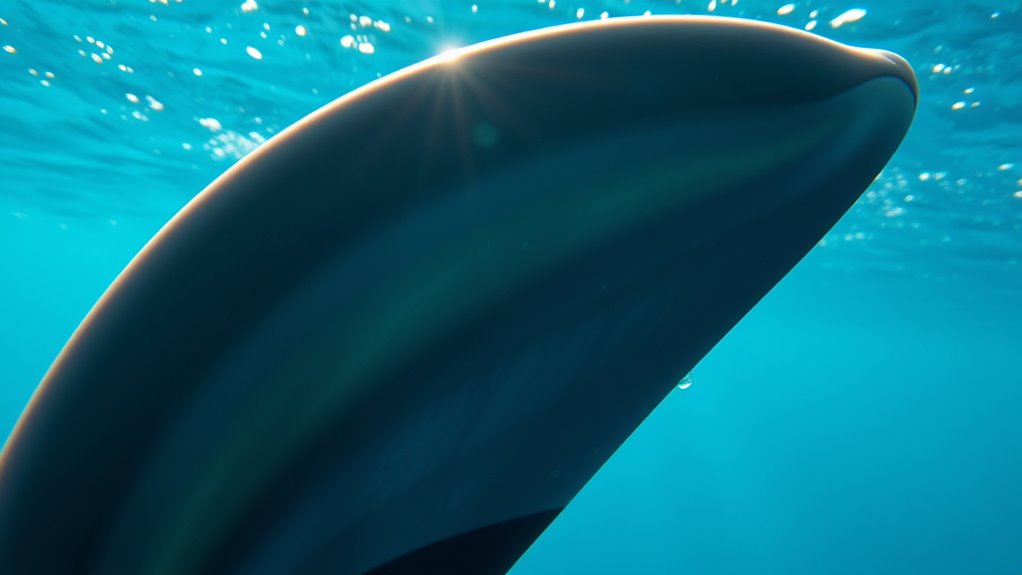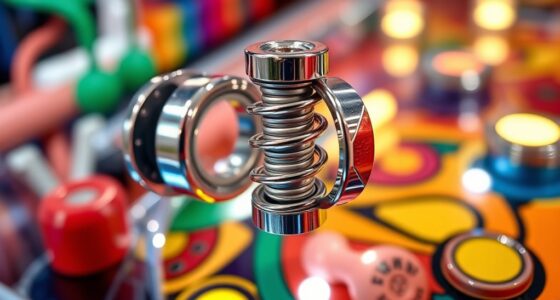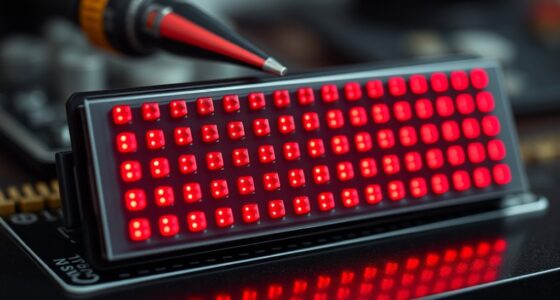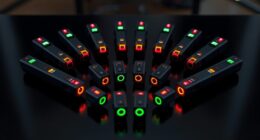The science behind flipper mechanics involves understanding how their shape, flexibility, and movement work together to propel water efficiently. Flippers are designed like wings, creating lift and thrust as you move them through water, with angles and flexible joints controlling force and maneuverability. The surface shape and material properties reduce drag while maximizing power. If you explore further, you’ll discover how natural evolution and engineering innovations truly optimize aquatic movement.
Key Takeaways
- Flipper shape and material properties optimize water flow, reducing drag and increasing propulsion efficiency through lift and thrust.
- Water flow around flippers depends on environmental factors, with biomimicry aiding in designing hydrodynamically efficient fins.
- The angle of attack controls lift and maneuverability, balancing thrust with stability during swimming movements.
- Propulsive strokes involve coordinated phases with limb flexion and oscillation frequency, maximizing thrust while minimizing resistance.
- Evolutionary adaptations in flipper design enhance maneuverability, energy efficiency, and stability across different marine species.
The Morphology of Marine Flippers
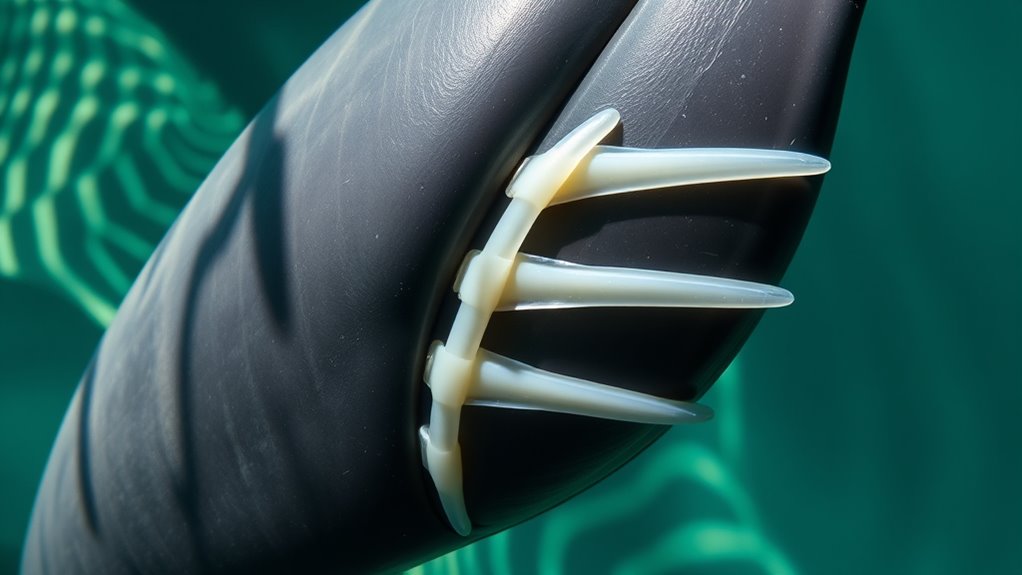
Marine flippers are specialized limbs that have evolved to optimize swimming efficiency. Their unique morphology allows marine animals to move smoothly through water. You’ll notice that the fin flap at the edge of a flipper helps generate lift and stability, acting like a wing in the air. The shape and flexibility of the flipper enable precise control during swimming. Additionally, the tail flick plays a pivotal role, providing powerful thrust to propel you forward. The tail flick, combined with the movement of the flippers, maximizes propulsion while minimizing energy expenditure. These adaptations work together to enhance maneuverability and speed, making marine creatures such as whales and dolphins agile swimmers. Understanding the morphology of flippers reveals how evolution fine-tunes limbs for aquatic life. Family background can influence the development of certain physical traits that assist in swimming.
Fluid Dynamics and Water Flow
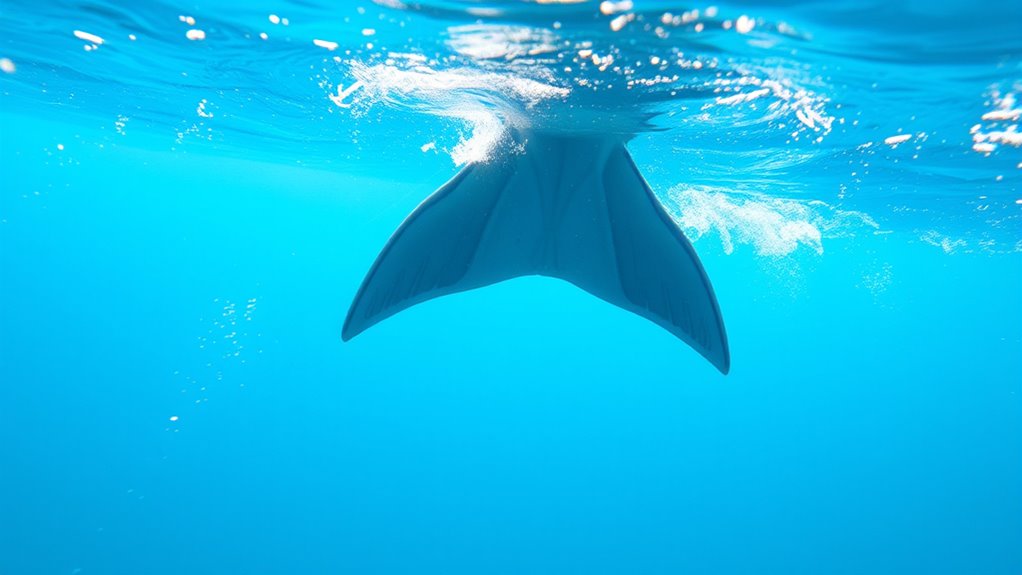
Understanding how water flows around flippers is essential to grasping their efficiency. The way fluid interacts with these structures involves complex fluid structure interactions, influencing propulsion. Biomimetic designs mimic natural flippers, optimizing water flow and reducing drag. By studying flow patterns, engineers develop more effective flippers that enhance swimming performance. Additionally, coastal wave action plays a role in shaping natural flipper design by affecting water movement around marine animals.
Lift Generation and Angle of Attack
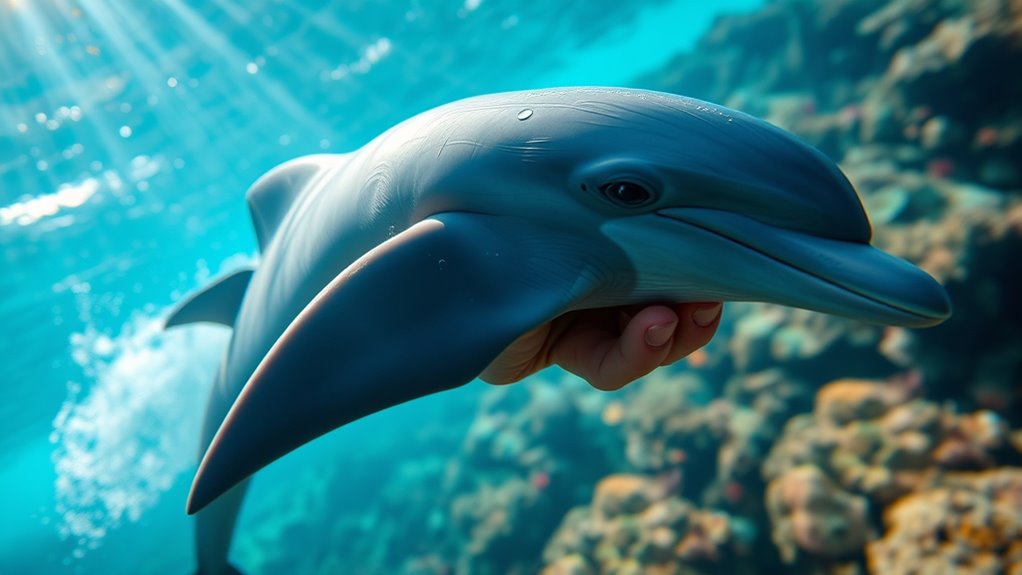
Have you ever wondered how flippers generate lift to help animals and robots stay stable and move efficiently through water? It all comes down to hydrodynamic lift, which depends on the angle of attack—the angle between the flipper’s surface and the water flow. When you tilt the flipper at the right angle, water flows faster over one side, creating pressure differences that produce lift. This lift counters gravity and helps stabilize the animal or robot during swimming. Adjusting the angle of attack allows precise control of lift, enabling smooth turns and efficient movement. Too steep an angle, and you risk stalling or increasing drag; too shallow, and you won’t generate enough lift. Mastering this balance is key to effective flipper mechanics underwater. Additionally, understanding symptoms of breast cancer can lead to early detection and better treatment outcomes.
The Role of Flipper Shape in Propulsion
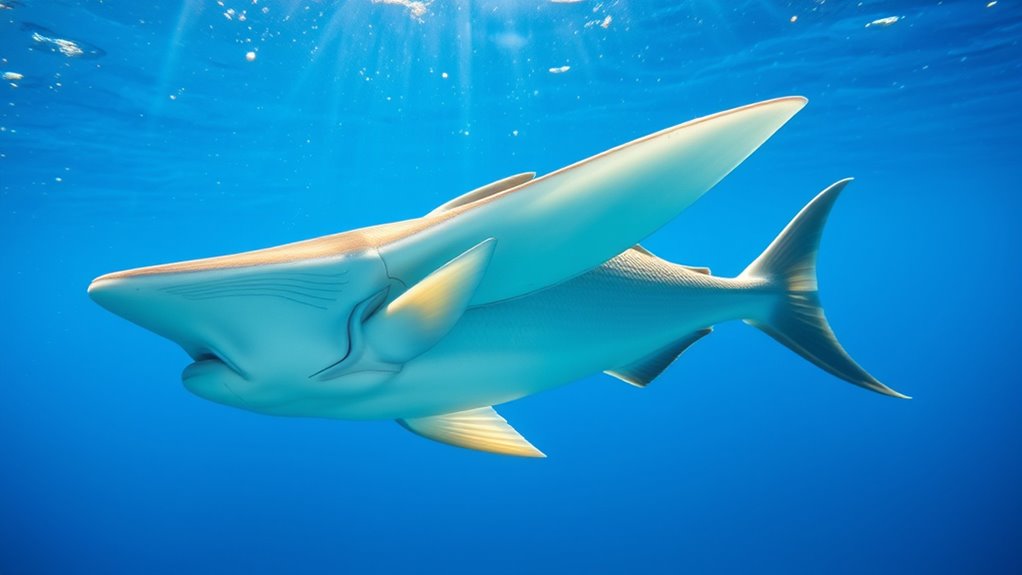
The shape of a flipper greatly influences how efficiently you move through the water. Hydrodynamic efficiency factors, like smooth contours and streamlined edges, help reduce drag and improve propulsion. By understanding how different contours impact flow, you can see how flipper design optimizes performance. Additionally, considering emotional support can be crucial in helping swimmers cope with performance anxiety and physical challenges associated with training.
Hydrodynamic Efficiency Factors
The shape of a flipper directly influences its ability to generate thrust efficiently through water. This is due to biomechanical adaptations that maximize hydrodynamic efficiency. Over time, evolutionary optimization has fine-tuned flipper contours to reduce drag and increase lift, allowing animals to move with minimal energy loss. Streamlined shapes, tapered edges, and curved surfaces help direct water flow smoothly past the flipper, creating ideal propulsion. These features minimize turbulence and resistance, enabling faster, more efficient swimming. The design reflects natural selection’s success in refining flipper morphology for different aquatic environments. By understanding these hydrodynamic efficiency factors, you see how evolutionary processes shape biomechanics to improve movement, highlighting the importance of shape in aquatic propulsion. Attention to detail is crucial for understanding how these features contribute to overall efficiency.
Impact of Flipper Contours
Flipper contours play a crucial role in enhancing propulsion by shaping how water flows around the limb. The specific shape of your flippers influences biomechanical adaptations that optimize thrust and maneuverability. Narrower, tapered contours reduce drag, allowing for smoother strokes, while broader edges increase surface area for greater force during propulsion. These design features reflect evolutionary significance, as marine animals have developed diverse flipper shapes to suit their environments and lifestyles. By understanding the impact of flipper contours, you can appreciate how natural selection has fine-tuned these structures for efficiency. The hydrodynamic properties of various flipper shapes directly affect their ability to generate force and glide through water, highlighting the importance of contour design in aquatic locomotion.
Material Properties and Flexibility
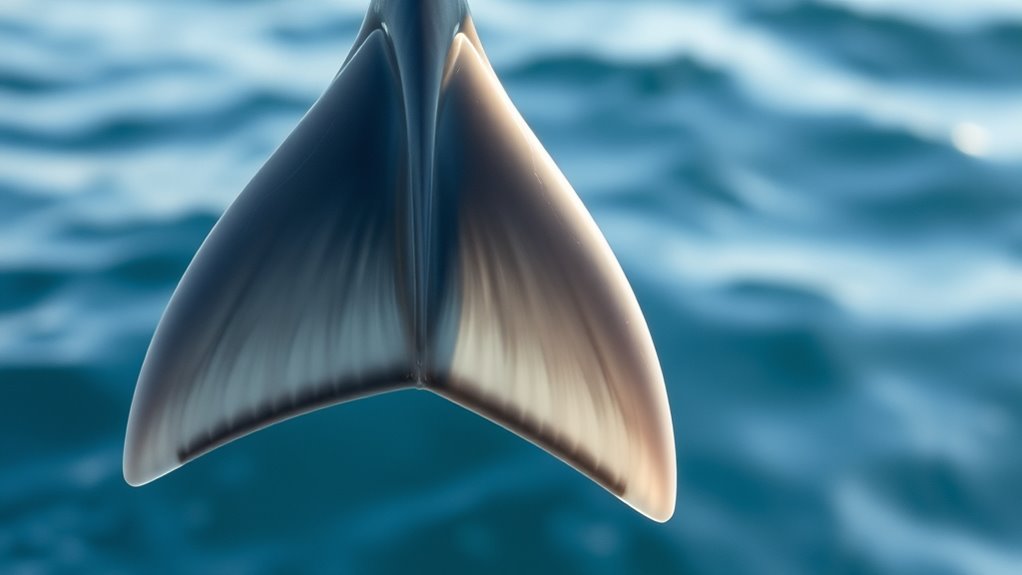
Understanding the material properties of flippers is essential because these characteristics directly influence their flexibility and performance in water. Material elasticity determines how well a flipper bends without breaking, while structural resilience ensures it can withstand repeated use and stress. When selecting materials, think about how these traits affect your swimming efficiency and comfort. Flexible flippers allow smoother propulsion, reducing fatigue, while resilient materials maintain shape and function over time. Imagine a flipper that adapts to your movement, responding instantly without losing strength. Material durability plays a critical role in ensuring the longevity and consistent performance of your flippers. Here’s a glimpse into how different materials impact performance:
| Material Type | Elasticity Level | Resilience Strength |
|---|---|---|
| Rubber | High | Moderate |
| Silicone | Very high | High |
| Thermoplastic | Moderate | High |
| Carbon Fiber | Low | Very high |
| Plastic | Low | Moderate |
Kinematic Movement Patterns of Flippers
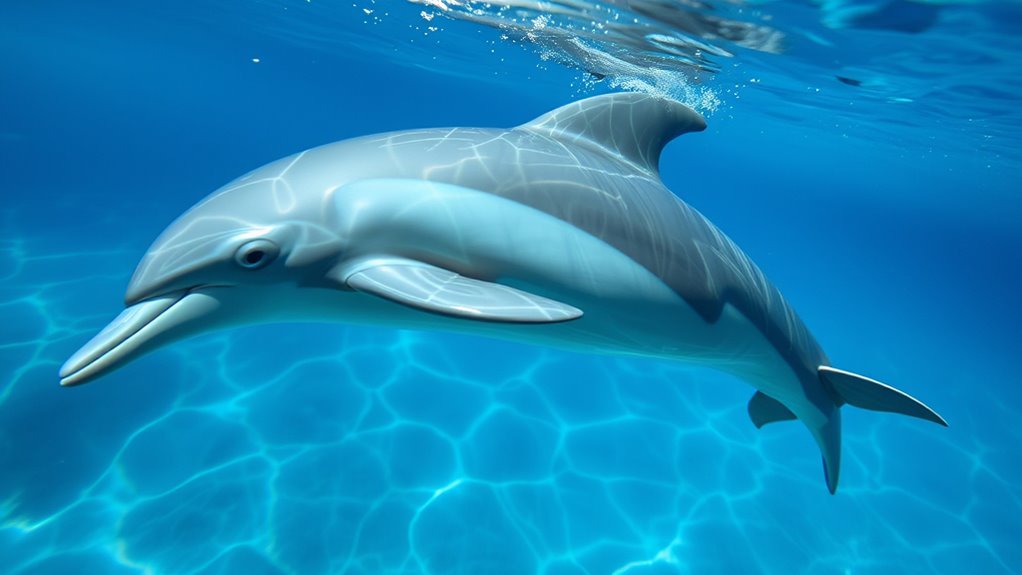
Understanding how flippers move involves examining limb flexion dynamics and how they generate propulsion. You’ll see that propulsive stroke phases are carefully coordinated to maximize efficiency, with each phase playing a crucial role. Controlling oscillation frequency allows for smooth, sustained movement, making flippers highly effective in aquatic locomotion.
Limb Flexion Dynamics
How do limb movements enhance propulsion and maneuverability in aquatic environments? Limb flexion dynamics play a key role, as muscle activation controls joint articulation, allowing efficient movement. When you flex your flippers, your muscles contract precisely to bend the joints, creating powerful strokes. This joint articulation enables smooth progressions between extension and flexion, maximizing lift and thrust. Proper limb flexion reduces drag and enhances maneuverability by fine-tuning the angle and speed of motion. Here’s a quick overview:
| Movement Stage | Muscle Activation | Effect on Flexion |
|---|---|---|
| Initiation | Sudden contraction | Bends joints |
| Mid-Flexion | Sustained contraction | Maintains bend |
| Extension | Relaxation or opposing muscles | Straightens joints |
This coordinated activity ensures optimal limb flexion dynamics for efficient swimming.
Propulsive Stroke Phases
The propulsive stroke phases of flippers involve a series of coordinated movements that generate thrust and propel aquatic creatures forward. In marine bioengineering, understanding these phases helps explain how flipper design influences efficiency. During the power phase, you push water backward with a sweeping motion, maximizing thrust. This movement is made possible by the evolutionary changes in flipper structure—wider, more flexible, and better suited for propulsion. As your flipper moves through the recovery phase, it lifts out of the water, preparing for the next stroke with minimal resistance. This cycle of extension and retraction showcases how flipper evolution optimized these motions for energy-efficient swimming. Recognizing these phases highlights the intricate biomechanics behind aquatic locomotion and informs bioengineering approaches to mimic natural propulsion systems. Additionally, insights from Kia Tuning demonstrate how structural modifications can enhance overall performance, paralleling how evolutionary adaptations improve biological efficiency.
Oscillation Frequency Control
Oscillation frequency control determines how often your flippers complete each cycle of propulsion, directly affecting swimming speed and energy efficiency. When you fine-tune this frequency, you maximize muscle coordination and respond effectively to sensory feedback, ensuring smooth, powerful strokes. Higher frequencies mean rapid, repetitive movements, while lower frequencies allow for more controlled, deliberate kicks. Your nervous system adjusts oscillation based on water resistance and fatigue, maintaining optimal performance. Key aspects include:
- Precise timing of muscle activation
- Adjusting stroke rate to conserve energy
- Reacting to changes in water currents
- Synchronizing movements with sensory feedback
- Preventing overexertion through controlled oscillations
Mastering oscillation frequency control helps you swim faster with less effort, leveraging your body’s natural feedback mechanisms for peak efficiency. Understanding muscle coordination can further enhance your ability to fine-tune your movements effectively.
Energy Efficiency in Flipper Motion
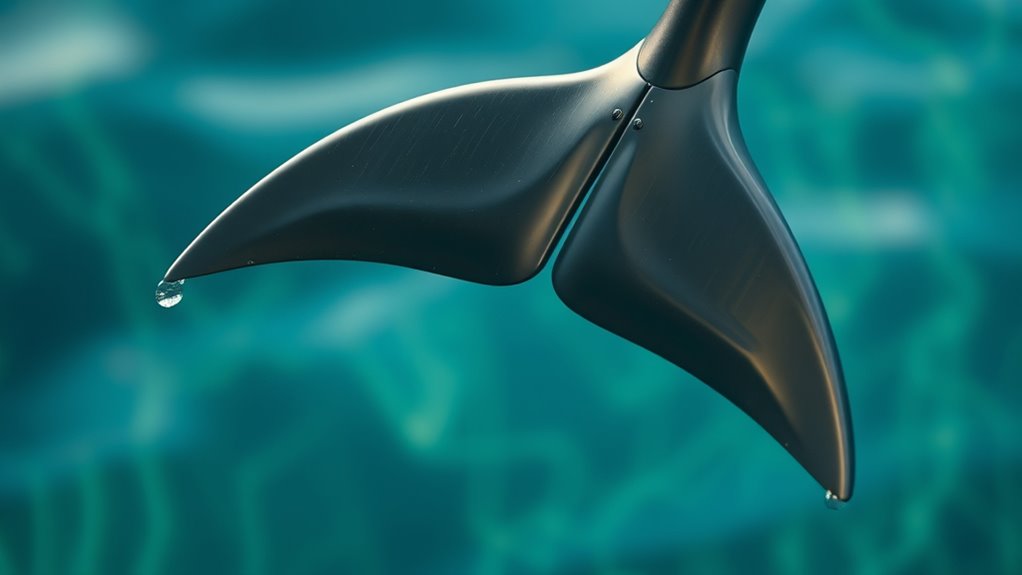
Have you ever wondered what makes flipper motion so energy-efficient? It’s rooted in biomechanical adaptation and evolutionary development, optimizing movement to reduce energy loss. Flippers are designed to maximize thrust while minimizing drag, using smooth, controlled motions. This efficiency is achieved through specialized muscle structures and flexible cartilage that allow seamless power transfer. Here’s a quick look at how these features work:
| Feature | Benefit |
|---|---|
| Streamlined Shape | Lowers drag during movement |
| Flexible Cartilage | Enhances fluid motion |
| Strong Musculature | Generates powerful strokes with less effort |
| Coordinated Fins | Improves thrust efficiency |
| Evolutionary Optimization | Continual refinement for energy conservation |
Comparative Analysis of Different Marine Species

Different marine species have evolved unique flipper designs that optimize movement within their specific environments. These evolutionary adaptations help them navigate their distinct marine habitats, from shallow reefs to deep ocean trenches. For example:
Marine species’ flippers are uniquely adapted to thrive in their specific aquatic environments.
- Dolphin flippers with streamlined, curved shapes for high-speed swimming.
- Seal flippers featuring flexible joints for agile turns and underwater agility.
- Sea turtle flippers broad and paddle-like, perfect for steady, slow movement.
- Manta ray pectoral fins acting like wings for gliding through open water.
- Crocodile-like marine reptiles with robust, paddle-shaped flippers for stability.
These variations highlight how evolution tailors flipper mechanics to maximize efficiency and survival in diverse aquatic settings. Understanding these differences reveals the fascinating ways marine species adapt their morphology to thrive in their unique habitats. Evolutionary adaptations play a crucial role in shaping the form and function of these diverse flipper designs.
Innovations Inspired by Flipper Mechanics
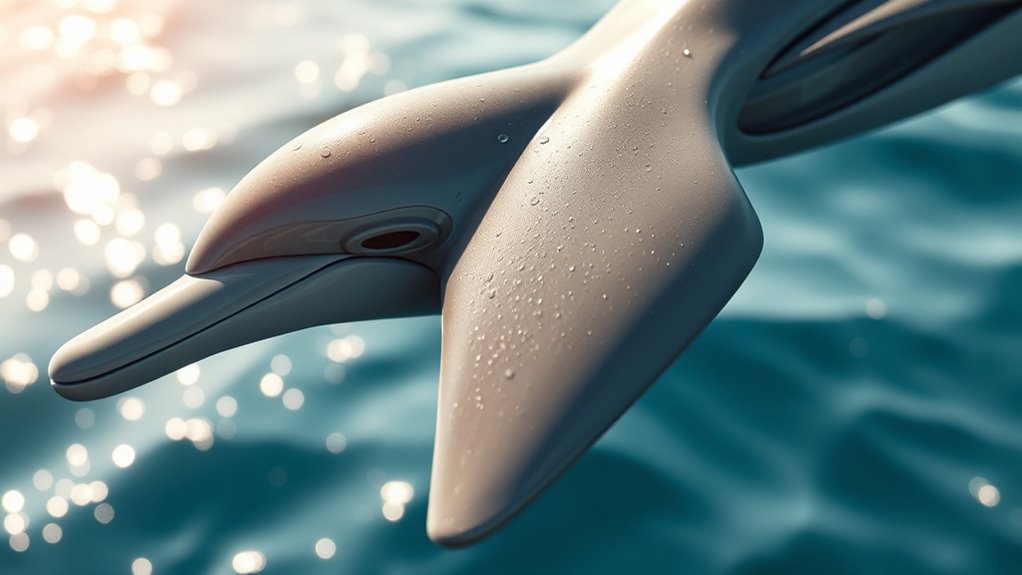
The efficient design principles of marine flippers have sparked innovative advancements across various engineering fields. By studying their biomechanical adaptations, engineers have developed more efficient underwater vehicles and robotic systems. These adaptations, honed through evolutionary development, reveal how streamlined shapes and flexible structures optimize movement and energy use. For example, bio-inspired fins and propellers mimic the flipper’s ability to generate thrust with minimal resistance. This approach enhances maneuverability, stability, and efficiency in aquatic environments. The insights gained from natural flipper mechanics have also influenced the design of wearable prosthetics and robotic limbs, improving mobility for humans and animals alike. Ultimately, these innovations demonstrate how understanding evolutionary development can inspire smarter, more sustainable engineering solutions rooted in nature’s proven designs.
Frequently Asked Questions
How Do Flipper Mechanics Vary Among Different Aquatic Environments?
You’ll notice that flipper mechanics vary among aquatic environments because animals adapt for ideal hydrodynamic efficiency. In fast-moving waters, they develop streamlined shapes for swift movement, while in calmer environments, they may have broader, more flexible flippers for better maneuverability. These differences showcase environmental adaptation, allowing marine creatures to conserve energy, improve their agility, and thrive in diverse habitats.
What Role Does Muscle Control Play in Flipper Movement Precision?
You play a vital role in flipper movement precision through muscle coordination and neural control. Your brain sends signals that synchronize your muscles, allowing for smooth, accurate movements. When your neural control is finely tuned, your muscle coordination improves, leading to more precise flipper actions. This delicate balance between neural control and muscle coordination enables efficient swimming, maneuvering, and adaptation to various aquatic environments, showcasing the complexity of your body’s remarkable motor system.
Can Flipper Design Be Applied to Underwater Robotics Effectively?
You can definitely apply flipper design to underwater robotics effectively by focusing on biomechanical optimization and material engineering. By mimicking natural flippers, you enhance maneuverability and efficiency. Using advanced materials, you reduce weight while maintaining durability. Incorporating precise control systems allows your robot to replicate the fluid, powerful movements found in marine life. This approach results in more agile, energy-efficient underwater robots suited for exploration, research, and rescue missions.
How Does Age or Health Affect a Marine Animal’S Flipper Function?
Imagine your flippers turning into fragile, ancient relics—age or health issues can cause a significant decline in marine animals’ flipper function. You’d notice less agility and strength, making it harder to swim or hunt. Age-related decline and health implications directly affect their mobility, just like it would for you. Maintaining good health is essential to keep their flippers powerful, enabling them to thrive in their underwater world.
Are There Evolutionary Trade-Offs in Flipper Morphology Across Species?
You’re curious if there are trade-offs in flipper evolution across species. Evolution often favors morphological diversity that suits specific environments, but this can come with trade-offs. For example, a streamlined shape improves speed but might reduce maneuverability. These trade-offs reflect how natural selection balances different needs, leading to diverse flipper forms across marine animals. So, evolution shapes flipper morphology by weighing benefits and limitations, creating specialized adaptations.
Conclusion
By understanding how marine flippers work, you can appreciate their incredible efficiency—like the humpback whale’s flipper, which uses unique bumps to generate lift. Imagine applying this knowledge to design more energy-efficient underwater robots or surfboards that mimic natural movement. As you explore flipper mechanics, you’ll see how science reveal innovations, helping us create better aquatic technologies and deepening your appreciation for the remarkable adaptations of marine life.
